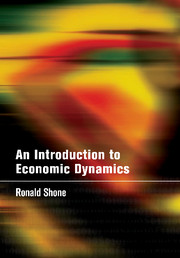Book contents
- Frontmatter
- Contents
- List of tables and boxes
- Preface
- 1 Introduction
- 2 Demand and supply dynamics
- 3 Simple Keynesian dynamics
- 4 Constructing trajectories in the phase plane
- 5 IS-LM dynamics
- 6 Inflation–unemployment dynamics
- 7 Dynamics of the firm
- 8 Saddles and rational expectations
- 9 Fiscal dynamics and the Maastricht Treaty
- 10 A little bit of chaos
- Brief answers to selected exercises
- Further reading
- Index
1 - Introduction
Published online by Cambridge University Press: 05 June 2012
- Frontmatter
- Contents
- List of tables and boxes
- Preface
- 1 Introduction
- 2 Demand and supply dynamics
- 3 Simple Keynesian dynamics
- 4 Constructing trajectories in the phase plane
- 5 IS-LM dynamics
- 6 Inflation–unemployment dynamics
- 7 Dynamics of the firm
- 8 Saddles and rational expectations
- 9 Fiscal dynamics and the Maastricht Treaty
- 10 A little bit of chaos
- Brief answers to selected exercises
- Further reading
- Index
Summary
In this chapter we shall introduce some basic concepts of dynamics. In order to illustrate these we shall consider just one example. This example is a simple linear model. Why such a linear equation explains what is of interest we shall not consider here. Our main aim is to define and elaborate on dynamic concepts that we shall use throughout this book. Our second aim is to show how such a model can be set up on a spreadsheet and then investigated interactively.
Definitions and concepts
Dynamics is concerned with how things change over time. The passage of time is a crucial element in any dynamic process. Whether a variable remains the same value at two points in time or whether it is different is not the essential issue, what matters is that time has elapsed between the value of the variable on the first occasion and the value it takes on the second. Time cannot be reversed.
In dynamics we must specify the point in time for any given variable. If we are concerned about national income, price or profits we need to specify the level of income at a point in time, the price at a point in time and profits at some point in time. As time moves on the value these variables take may change. We will specify time in this book by referring to periods: period 0, usually referring to the initial point in time, then period 1, period 2, and so on.
- Type
- Chapter
- Information
- An Introduction to Economic Dynamics , pp. 1 - 26Publisher: Cambridge University PressPrint publication year: 2001



